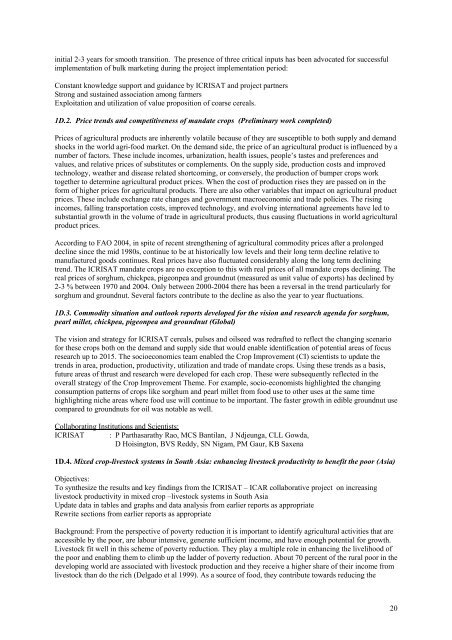ICRISAT Archival Report 2006 - The seedlings of success in the ...
ICRISAT Archival Report 2006 - The seedlings of success in the ...
ICRISAT Archival Report 2006 - The seedlings of success in the ...
You also want an ePaper? Increase the reach of your titles
YUMPU automatically turns print PDFs into web optimized ePapers that Google loves.
<strong>in</strong>itial 2-3 years for smooth transition. <strong>The</strong> presence <strong>of</strong> three critical <strong>in</strong>puts has been advocated for <strong>success</strong>ful<br />
implementation <strong>of</strong> bulk market<strong>in</strong>g dur<strong>in</strong>g <strong>the</strong> project implementation period:<br />
Constant knowledge support and guidance by <strong>ICRISAT</strong> and project partners<br />
Strong and susta<strong>in</strong>ed association among farmers<br />
Exploitation and utilization <strong>of</strong> value proposition <strong>of</strong> coarse cereals.<br />
1D.2. Price trends and competitiveness <strong>of</strong> mandate crops (Prelim<strong>in</strong>ary work completed)<br />
Prices <strong>of</strong> agricultural products are <strong>in</strong>herently volatile because <strong>of</strong> <strong>the</strong>y are susceptible to both supply and demand<br />
shocks <strong>in</strong> <strong>the</strong> world agri-food market. On <strong>the</strong> demand side, <strong>the</strong> price <strong>of</strong> an agricultural product is <strong>in</strong>fluenced by a<br />
number <strong>of</strong> factors. <strong>The</strong>se <strong>in</strong>clude <strong>in</strong>comes, urbanization, health issues, people’s tastes and preferences and<br />
values, and relative prices <strong>of</strong> substitutes or complements. On <strong>the</strong> supply side, production costs and improved<br />
technology, wea<strong>the</strong>r and disease related shortcom<strong>in</strong>g, or conversely, <strong>the</strong> production <strong>of</strong> bumper crops work<br />
toge<strong>the</strong>r to determ<strong>in</strong>e agricultural product prices. When <strong>the</strong> cost <strong>of</strong> production rises <strong>the</strong>y are passed on <strong>in</strong> <strong>the</strong><br />
form <strong>of</strong> higher prices for agricultural products. <strong>The</strong>re are also o<strong>the</strong>r variables that impact on agricultural product<br />
prices. <strong>The</strong>se <strong>in</strong>clude exchange rate changes and government macroeconomic and trade policies. <strong>The</strong> ris<strong>in</strong>g<br />
<strong>in</strong>comes, fall<strong>in</strong>g transportation costs, improved technology, and evolv<strong>in</strong>g <strong>in</strong>ternational agreements have led to<br />
substantial growth <strong>in</strong> <strong>the</strong> volume <strong>of</strong> trade <strong>in</strong> agricultural products, thus caus<strong>in</strong>g fluctuations <strong>in</strong> world agricultural<br />
product prices.<br />
Accord<strong>in</strong>g to FAO 2004, <strong>in</strong> spite <strong>of</strong> recent streng<strong>the</strong>n<strong>in</strong>g <strong>of</strong> agricultural commodity prices after a prolonged<br />
decl<strong>in</strong>e s<strong>in</strong>ce <strong>the</strong> mid 1980s, cont<strong>in</strong>ue to be at historically low levels and <strong>the</strong>ir long term decl<strong>in</strong>e relative to<br />
manufactured goods cont<strong>in</strong>ues. Real prices have also fluctuated considerably along <strong>the</strong> long term decl<strong>in</strong><strong>in</strong>g<br />
trend. <strong>The</strong> <strong>ICRISAT</strong> mandate crops are no exception to this with real prices <strong>of</strong> all mandate crops decl<strong>in</strong><strong>in</strong>g. <strong>The</strong><br />
real prices <strong>of</strong> sorghum, chickpea, pigeonpea and groundnut (measured as unit value <strong>of</strong> exports) has decl<strong>in</strong>ed by<br />
2-3 % between 1970 and 2004. Only between 2000-2004 <strong>the</strong>re has been a reversal <strong>in</strong> <strong>the</strong> trend particularly for<br />
sorghum and groundnut. Several factors contribute to <strong>the</strong> decl<strong>in</strong>e as also <strong>the</strong> year to year fluctuations.<br />
1D.3. Commodity situation and outlook reports developed for <strong>the</strong> vision and research agenda for sorghum,<br />
pearl millet, chickpea, pigeonpea and groundnut (Global)<br />
<strong>The</strong> vision and strategy for <strong>ICRISAT</strong> cereals, pulses and oilseed was redrafted to reflect <strong>the</strong> chang<strong>in</strong>g scenario<br />
for <strong>the</strong>se crops both on <strong>the</strong> demand and supply side that would enable identification <strong>of</strong> potential areas <strong>of</strong> focus<br />
research up to 2015. <strong>The</strong> socioeconomics team enabled <strong>the</strong> Crop Improvement (CI) scientists to update <strong>the</strong><br />
trends <strong>in</strong> area, production, productivity, utilization and trade <strong>of</strong> mandate crops. Us<strong>in</strong>g <strong>the</strong>se trends as a basis,<br />
future areas <strong>of</strong> thrust and research were developed for each crop. <strong>The</strong>se were subsequently reflected <strong>in</strong> <strong>the</strong><br />
overall strategy <strong>of</strong> <strong>the</strong> Crop Improvement <strong>The</strong>me. For example, socio-economists highlighted <strong>the</strong> chang<strong>in</strong>g<br />
consumption patterns <strong>of</strong> crops like sorghum and pearl millet from food use to o<strong>the</strong>r uses at <strong>the</strong> same time<br />
highlight<strong>in</strong>g niche areas where food use will cont<strong>in</strong>ue to be important. <strong>The</strong> faster growth <strong>in</strong> edible groundnut use<br />
compared to groundnuts for oil was notable as well.<br />
Collaborat<strong>in</strong>g Institutions and Scientists:<br />
<strong>ICRISAT</strong> : P Parthasarathy Rao, MCS Bantilan, J Ndjeunga, CLL Gowda,<br />
D Hois<strong>in</strong>gton, BVS Reddy, SN Nigam, PM Gaur, KB Saxena<br />
1D.4. Mixed crop-livestock systems <strong>in</strong> South Asia: enhanc<strong>in</strong>g livestock productivity to benefit <strong>the</strong> poor (Asia)<br />
Objectives:<br />
To syn<strong>the</strong>size <strong>the</strong> results and key f<strong>in</strong>d<strong>in</strong>gs from <strong>the</strong> <strong>ICRISAT</strong> – ICAR collaborative project on <strong>in</strong>creas<strong>in</strong>g<br />
livestock productivity <strong>in</strong> mixed crop –livestock systems <strong>in</strong> South Asia<br />
Update data <strong>in</strong> tables and graphs and data analysis from earlier reports as appropriate<br />
Rewrite sections from earlier reports as appropriate<br />
Background: From <strong>the</strong> perspective <strong>of</strong> poverty reduction it is important to identify agricultural activities that are<br />
accessible by <strong>the</strong> poor, are labour <strong>in</strong>tensive, generate sufficient <strong>in</strong>come, and have enough potential for growth.<br />
Livestock fit well <strong>in</strong> this scheme <strong>of</strong> poverty reduction. <strong>The</strong>y play a multiple role <strong>in</strong> enhanc<strong>in</strong>g <strong>the</strong> livelihood <strong>of</strong><br />
<strong>the</strong> poor and enabl<strong>in</strong>g <strong>the</strong>m to climb up <strong>the</strong> ladder <strong>of</strong> poverty reduction. About 70 percent <strong>of</strong> <strong>the</strong> rural poor <strong>in</strong> <strong>the</strong><br />
develop<strong>in</strong>g world are associated with livestock production and <strong>the</strong>y receive a higher share <strong>of</strong> <strong>the</strong>ir <strong>in</strong>come from<br />
livestock than do <strong>the</strong> rich (Delgado et al 1999). As a source <strong>of</strong> food, <strong>the</strong>y contribute towards reduc<strong>in</strong>g <strong>the</strong><br />
20

















